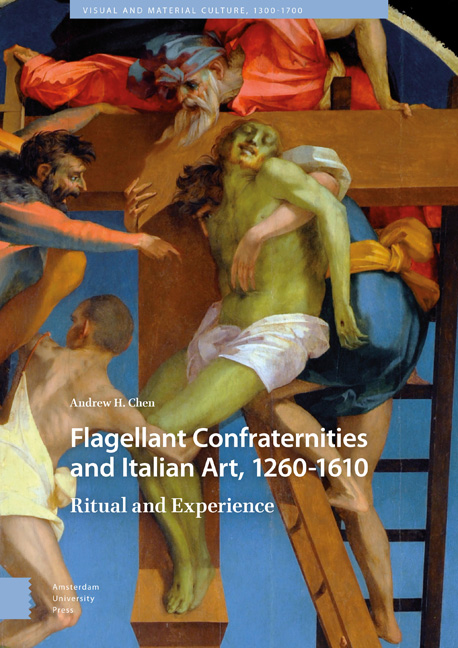Book contents
- Frontmatter
- Deduction
- Contents
- Abbreviations
- List of Illustrations
- Acknowledgements
- Introduction
- Part I Art and Ritual, to 1450
- 1 Flagellation and Its Settings
- 2 Images at Entrances, and Ascesis
- 3 Mass
- 4 Comforting
- 5 Processions
- Part II Transformations
- 6 Changes in Ritual Before Trent
- 7 Changes in imagery before Trent: Sansepolcro and Volterra
- 8 After Trent: Florence and Milan
- Epilogue: Global Flagellation
- Bibliography
- Index of Illuminated Manuscripts (by location)
- Index of Paintings (by location)
- Index of Topics
- Frontmatter
- Deduction
- Contents
- Abbreviations
- List of Illustrations
- Acknowledgements
- Introduction
- Part I Art and Ritual, to 1450
- 1 Flagellation and Its Settings
- 2 Images at Entrances, and Ascesis
- 3 Mass
- 4 Comforting
- 5 Processions
- Part II Transformations
- 6 Changes in Ritual Before Trent
- 7 Changes in imagery before Trent: Sansepolcro and Volterra
- 8 After Trent: Florence and Milan
- Epilogue: Global Flagellation
- Bibliography
- Index of Illuminated Manuscripts (by location)
- Index of Paintings (by location)
- Index of Topics
Summary
What does it mean to engage with an artwork, and what did it mean in the Middle Ages and the Renaissance? Immanuel Kant believed that engagement happens in the mind, that pleasure in the beautiful is the result of a ‘free play’ of the cognitive faculties upon assimilation of forms. Alois Riegl's and Heinrich Wölfflin's conceptions of experience were neo-Kantian to the extent that both treated interactions of forms, eyes, and mind as isolable. Riegl held that ancient artworks were made to be viewed in particular ways; ancient Egyptian art, for example, invites a close-up kind of looking that is almost tactile. Late Roman art willed audiences to purely apprehend forms presented with rhythmic intervals of space in between. This strategy of presentation Riegl saw as commensurate with the philosophic worldview of early Christianity. Wölfflin, who acknowledges Riegl in the preface to his Principles of Art History of 1915, suggested that aesthetic properties like clarity and unclarity have different effects on the mind: ‘Anything set up for perfect clarity arouses the suspicion that it might lack vitality’, whereas a lack of clarity can be satisfying. It is evident that Wolfflin believed in the potential for stylistic data to be used in the writing of histories of taste and perception.
A locus classicus for aesthetics of reception in anglophone art history is E.H. Gombrich's Art and Illusion, a book in which innovations in art are analysed in terms of the way they invite processing in the mind; art making is inscribed within a psychological framework of art viewing. The masters of illusionistic painting tinkered with the representational conventions they knew with a view to making their pictures ever more convincing. Gombrich called the range of expectations audiences brought to bear on experiences of art, and of other forms of cultural communication, their ‘mental set’. These ideas were to leave a deep impression on Michael Baxandall, who had joined the Warburg Institute shortly before Gombrich's 1956 Mellon Lectures were published in 1960. Baxandall wrote about perception in Painting and Experience in Fifteenth Century Italy as a person's ‘cognitive style’, which is historically contingent.
David Freedberg, until recently Director of the Warburg Institute, has been on a campaign to convince people that engagement with pictures happens fundamentally, and universally, at a pre-cognitive level. For Freedberg it is grounded in neuronal activity and involves a full-body response.
- Type
- Chapter
- Information
- Flagellant Confraternities and Italian Art, 1260–1610Ritual and Experience, pp. 21 - 30Publisher: Amsterdam University PressPrint publication year: 2018



